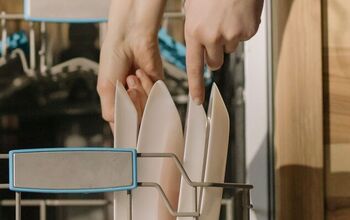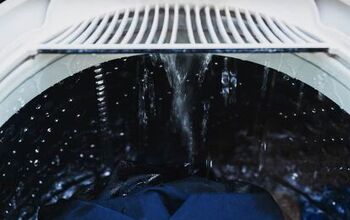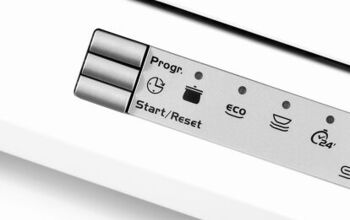Whirlpool Dishwasher Heated Dry Not Working? (Fix It Now!)

The dishwasher is one of the most vital appliances in a kitchen. Without a dishwasher, you could be facing lengthy dishwashing sessions by hand. That not only takes a lot of time and effort but can leave your hands pruned and smelling funky.
Whirlpool’s line of dishwashers is some of the most trusted and revered on the market today. They have built trust with their customer base throughout the years as one of the best around. But some customers may find that their dishwasher’s heated dry cycle is not working properly. More often than not, it is an issue with how the dishwasher is loaded. It can also be an issue with individual components like the vent, fan motor, or heating element.
If you are having issues with your Whirlpool spray arm, check out Whirlpool Dishwasher Spray Arm Not Spinning?
Do You Need Appliance Repair Services?
Get free, zero-commitment quotes from pro contractors near you.

Improperly Loaded Dishes
There is nothing quite like running a dishwasher cycle, opening the dishwasher at the end, and your dishes are still soaking wet. Modern dishwashers use a heated dry to get those dishes bone dry without streaking and spots.
The most common reason for the heated cycle seemingly not working is due to improper loading. The dishwasher makes things a lot easier but you still need to properly load the dishwasher for it to be effective.
Overloading is a common issue in households. Wanting to get all the dishes done at once often means cramming the dishwasher too full, rendering it nowhere near as effective as it normally would be. There are ways to load your dishwasher, depending on the rack in question.
Properly Loading the Dishwasher
If you find yourself as more of the “cram it until it can’t close” type, then things need to change. The dishwasher can make your life far easier but you have to make sure that it can do its job. Improper loading not only makes life more difficult for the dishwasher but keeps it from working properly.
Take a rack-by-rack approach to loading your dishwasher. Bowls and glasses should go on the top rack and be placed upside down. That allows them to be rinsed better, which also promotes quicker and more effective drying. When bowls and glasses tip right-side-up, water can become trapped inside, hampering the dry cycle even further.
The bottom rack of the dishwasher should have dishes facing inward for better air circulation and rinsing. Moreover, those dishes should not touch one another. They need all the proper spacing to ensure that there is enough air circulation during the drying cycle.
Finally, the silverware basket should avoid nesting whenever possible. When the dishes have been piling up, this may seem difficult, but try to alternate forks, knives, and spoons so that they don’t nest into one another. Some dishwashers even have compartments to keep things separated.
Heat Dry Has Not Been Selected
In just about any troubleshooting situation, the simplest solution is often the right one. If your dishwasher does not seem to be performing the heat dry cycle, it may be as simple as you forgetting to click the heat dry option.
Ensuring that this function has been selected before you run each cycle. By doing so, the heating element can be ready to go at the proper point in the cycle. Forgetting to press that heat dry button can leave your dishes far wetter at the end of the cycle.
Plastic Items Can Present Problems
Another common reason that your dishwasher’s heating cycle may not be performing up to snuff is due to an abundance of plastic dishes. Plastic does not retain heat in the way that ceramic, glass, and the various metals of dishes do.
Because plastic does not retain heat, the heated drying cycle may not be able to adequately dry those plastic items. If you have run a load with a lot of plastic items and notice a lot more moisture, the material of your dishes can be the leading cause.
Defective Parts
Unfortunately, not every explanation or fix is a simple one. You may have tried cutting down on plastic dishes in a single wash or ensuring that the racks are properly loaded but still face a dripping wet finish.
In that case, you are more than likely staring down a potentially defective part. Defective parts are generally the result of long-term wear and tear, though they can also just be faulty right out of the gate. There are a few components within your dishwasher that stand the most risk of being ineffective.
Broken Fan Motor
The venting systems in dishwashers use some kind of fan. The fan works to propel that moist air inside of the dishwasher cabinet off the dishes and out into the vents. The less moisture that is on the dishes, the better the heated cycle does.
When the fan motor is damaged or broken, or the blades do not turn freely, it won’t do its job. You can likewise test to make sure that the fan motor has continuity. If you notice damage or there is no continuity, then the motor will need to be replaced.
Failed Dishwasher Vent
Remember that the venting systems work by displacing the excess moisture and carrying into the vents. Those vents let that damp air out after the wash cycle, which gets rid of that excess moisture that can build up within.
When the vent fails to open properly, then that excess moisture becomes trapped and stays on the dishes. If the vent is damaged or broken, you will have to replace it entirely. Otherwise, your dishwasher will be fighting an uphill battle when it comes to the drying cycle.
Defective Heating Element
The fan and vent are not the only crucial factors when it comes to drying the dishes. There are some dishwashers that make use of a heating element to perform the drying cycle. The heating element makes the cabinet hot enough that the water eventually just evaporates.
Should the heating element fail to open up properly, then the dishes stay wet. Use a multimeter to test out the heating element. If there is no continuity, then the heating element will need to be replaced. Depending on your level of experience, you may be better of bringing in a professional to replace that heating element.
Heating Element Assembly
Those dishwashers that make use of a heating element for the drying cycle have two components: the heating element and the assembly. While it is more common for the element itself to break down over time, the assembly can also fail.
When the heating element or the assembly fails, then the dishes are unable to properly dry. You can check to see if the heating element assembly has burned out by using a multimeter. The multimeter will check it for continuity.
Should your multimeter fail to detect continuity in the heating element assembly, then you will have to replace the unit entirely. It is recommended that you bring in a professional to replace the assembly as they can be a bit more complicated, especially for amateur DIYers.
Do You Need Appliance Repair Services?
Get free, zero-commitment quotes from pro contractors near you.

Things to do to Aid in Drying
There are also a few things that you can do to ensure your dishes come out dry and clean. For one, unloading in the wrong order can lead to dishes remaining wet even after a full washer cycle.
Keep in mind that these techniques will only go so far. If you have a damaged component, for instance, those will need to be replaced in short order. Drying aids can really only go so far in their effectiveness. Using loading and unloading best practices is the surest way to go. They work to ensure that the heating cycle does its job and that you don’t have to contend with wet dishes upon completion.
Unload in the Right Order
Believe it or not, your unloading technique is just as crucial for dry dishes as your loading technique. Should your Whirlpool dishwasher leave dishes a little wetter than normal, then start by unloading the bottom rack first.
When you unload the top rack and the dishes are still wet, you run the risk of some of that water falling down onto the dishes below. And there is nothing more frustrating than having a dry dish that is suddenly wet again.
Use a Rinsing Aid
When you see rinsing aids advertising, the ideal is that it is there to make your dishes shine brighter than ever. But the key to a good drying cycle is in the way that it is rinsed. That is where rinse aids come into play.
Rinse aids work by making changes to the water’s structure. Those changes make it so that the water droplets run off of your dishware and glasses far more easily. The improved rinsing equates to a better overall drying session since the amount of water is substantially cut down.
Check to see what rinse aids are the most compatible for your dishwasher. The wrong rinse aid can clash with your dishwasher and create more problems than they are worth. But when you get it right, you have an effective tool that makes cleaning and drying dishes far easier than ever before.
More Related Guides

Ryan Womeldorf has more than a decade of experience writing. He loves to blog about construction, plumbing, and other home topics. Ryan also loves hockey and a lifelong Buffalo sports fan.
More by Ryan Womeldorf



























